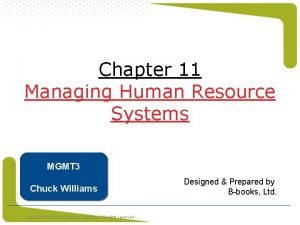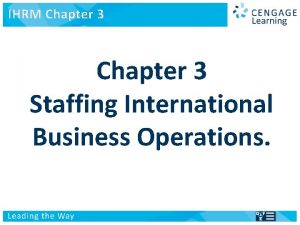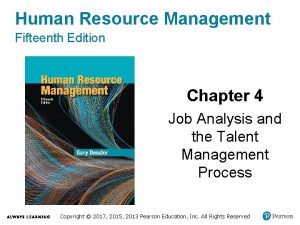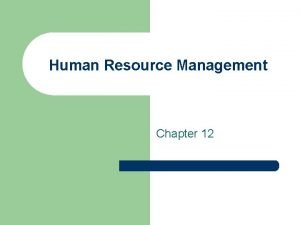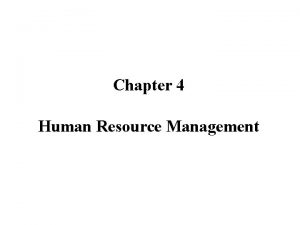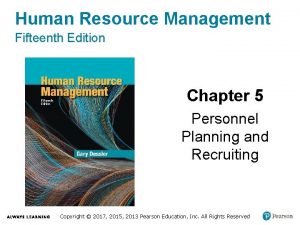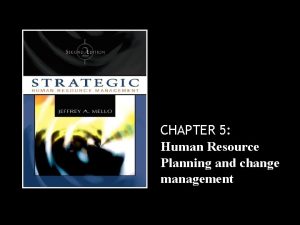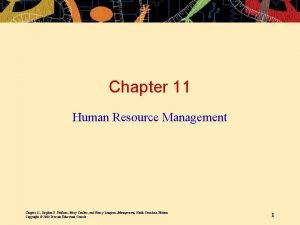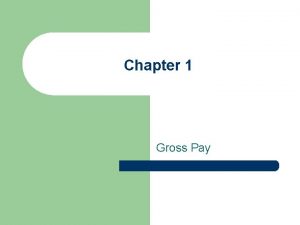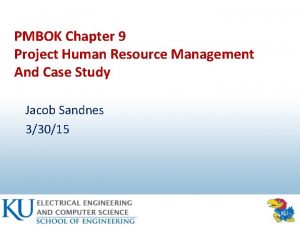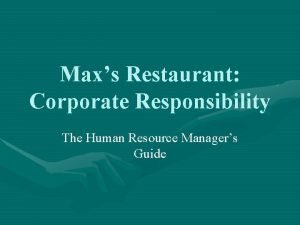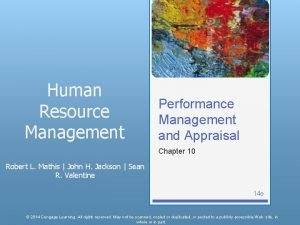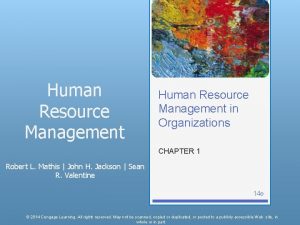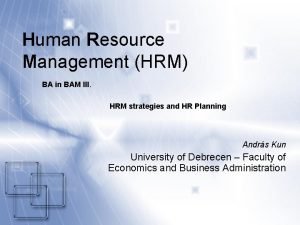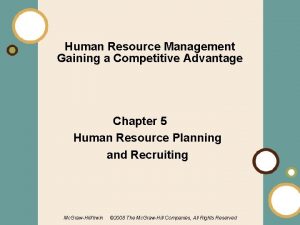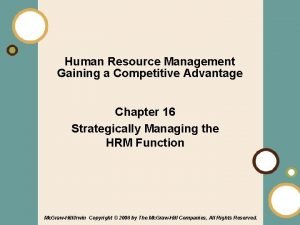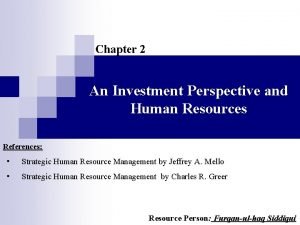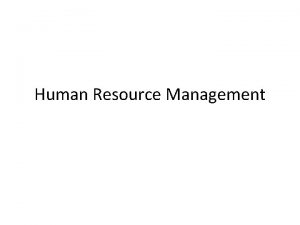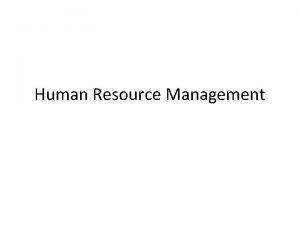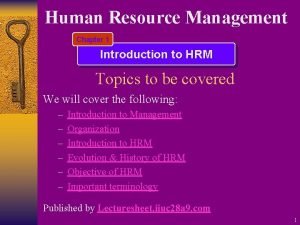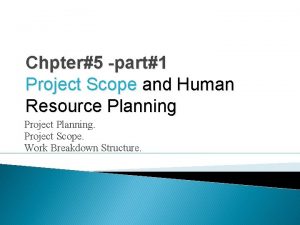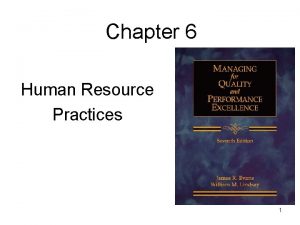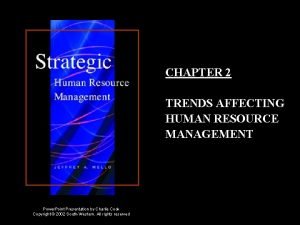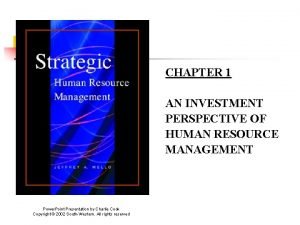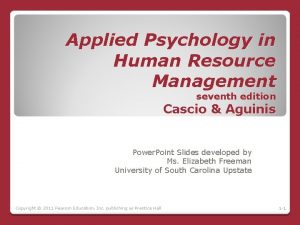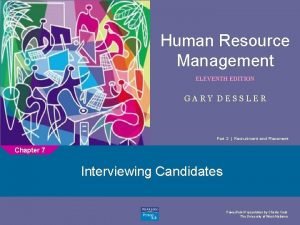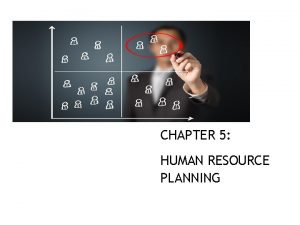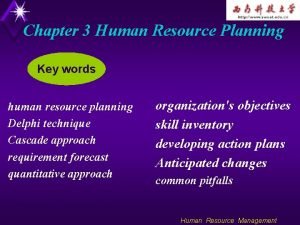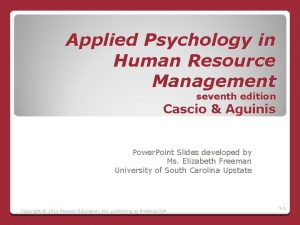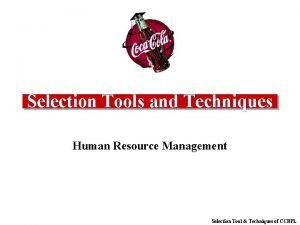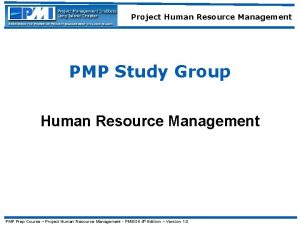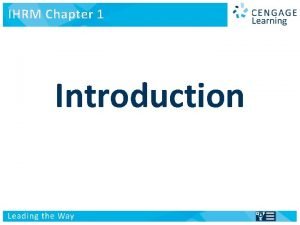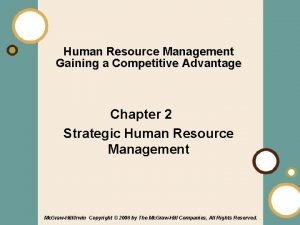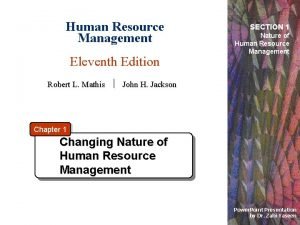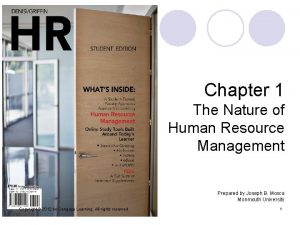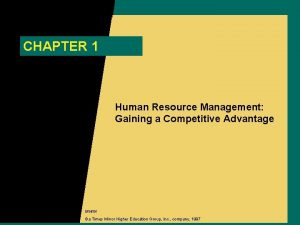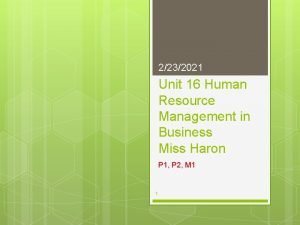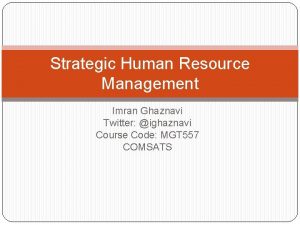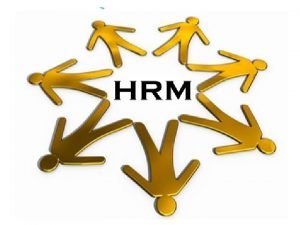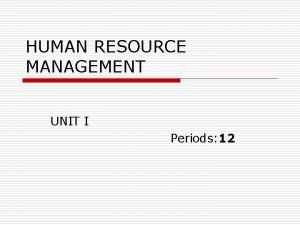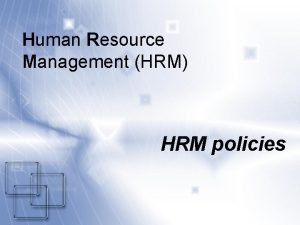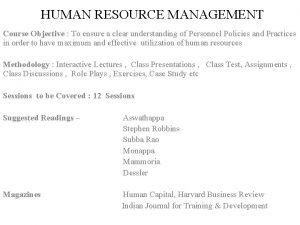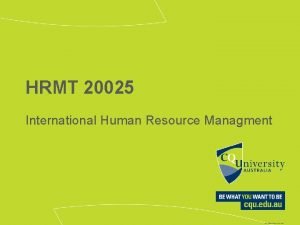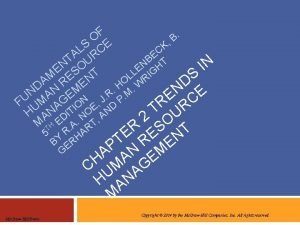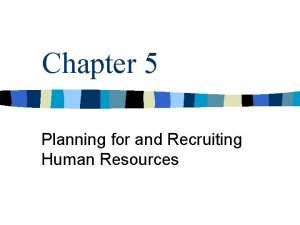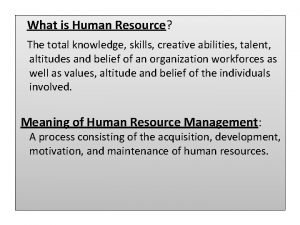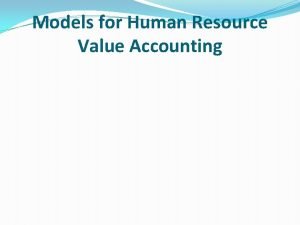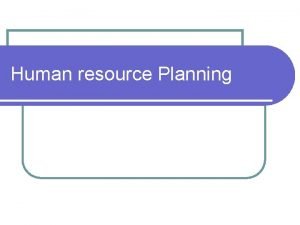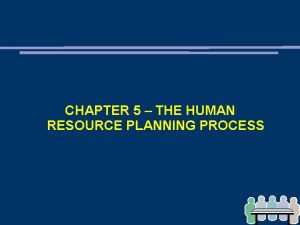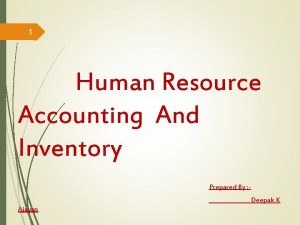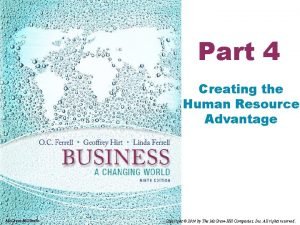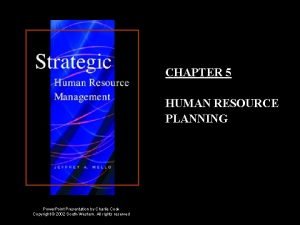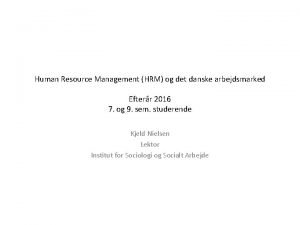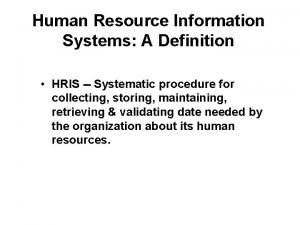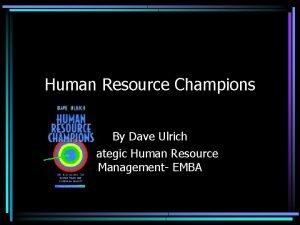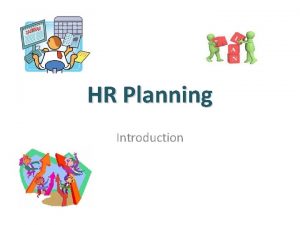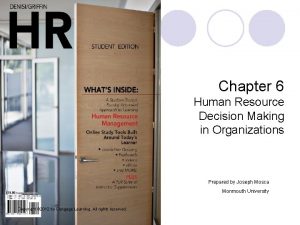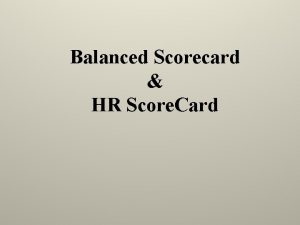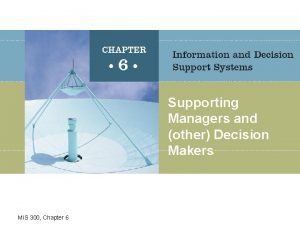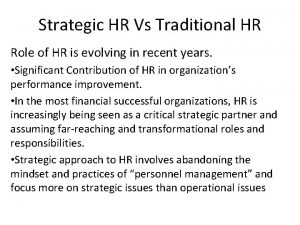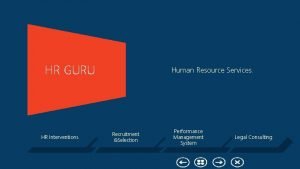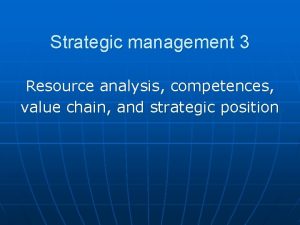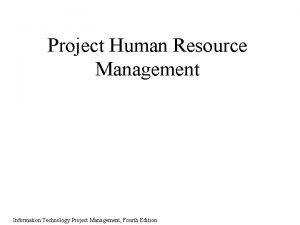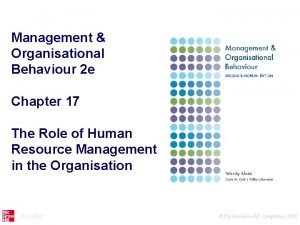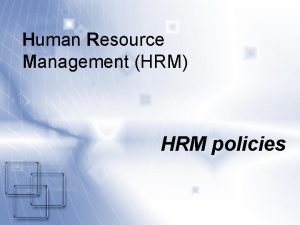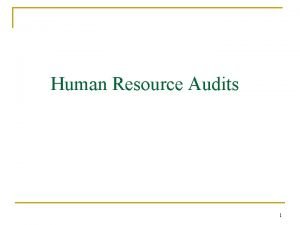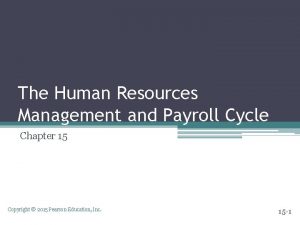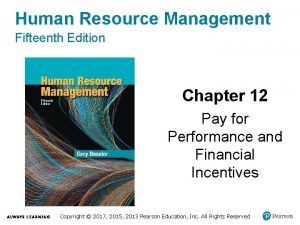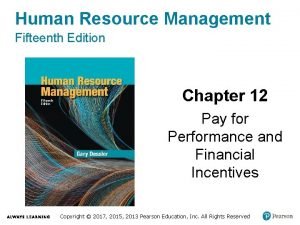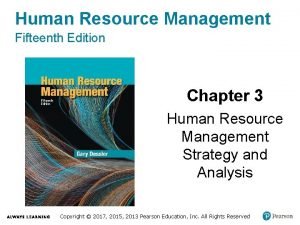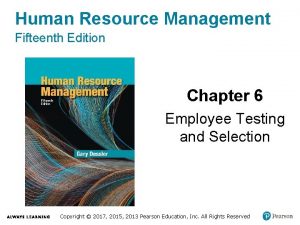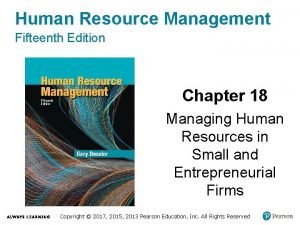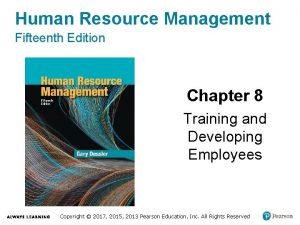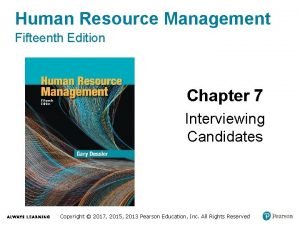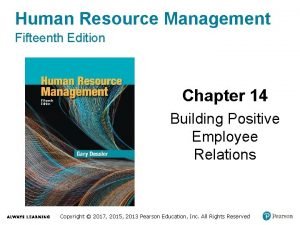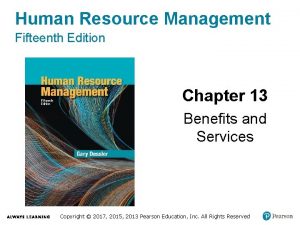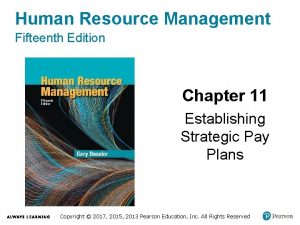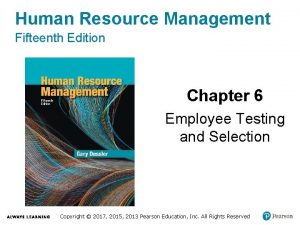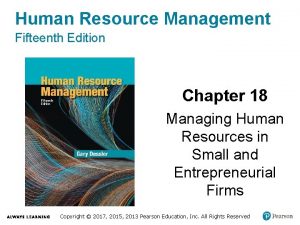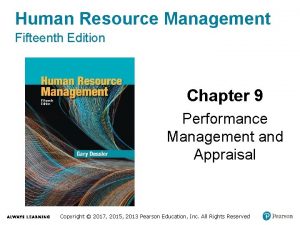Human Resource Management Fifteenth Edition Chapter 12 Pay































































































































































- Slides: 159

Human Resource Management Fifteenth Edition Chapter 12 Pay for Performance and Financial Incentives Copyright © 2017, 2015, 2013 Pearson Education, Inc. All Rights Reserved

Pay for Performance and Financial Incentives • Incentives are important in any pay plan. • The main purpose of this lecture is to explain how managers use incentives to motivate employees. • The main topics we’ll cover are money’s role in motivation, individual employee incentive and recognition programs, incentives for salespeople, incentives for managers and executives, team and organization-wide incentive plans, and incentives and employee engagement. Copyright © 2017, 2015, 2013 Pearson Education, Inc. All Rights Reserved

Learning Objectives (1 of 2) 12 -1. Explain how you would apply four motivation theories in formulating an incentive plan. 12 -2. Discuss the main incentives for individual employees. 12 -3. Discuss the pros and cons of commissions versus straight pay for salespeople. Copyright © 2017, 2015, 2013 Pearson Education, Inc. All Rights Reserved

Learning Objectives (2 of 2) 12 -4. Describe the main incentives for managers and executives. 12 -5. Name and describe the most popular organization-wide incentive plans. 12 -6. Explain how to use incentives to improve employee engagement. Copyright © 2017, 2015, 2013 Pearson Education, Inc. All Rights Reserved

I. Explain how you would apply four motivation theories in formulating an incentive plan. Copyright © 2017, 2015, 2013 Pearson Education, Inc. All Rights Reserved

Money and Motivation Copyright © 2017, 2015, 2013 Pearson Education, Inc. All Rights Reserved

Scientific management approach • Frederick Taylor was an American mechanical engineer who sought to improve industrial efficiencies. • He made three major contributions in the late 1800 s. First, he defined a fair’s day work using standards of output. • Second, he is known as the father of the scientific management approach. This approach emphasized improvement of work methods. • Finally, he recognized the use of financial incentives for those whose output exceeded standards. Copyright © 2017, 2015, 2013 Pearson Education, Inc. All Rights Reserved

Incentive Pay Terminology • Pay-for Performance • Variable Pay • Profit Sharing Copyright © 2017, 2015, 2013 Pearson Education, Inc. All Rights Reserved

Incentive plans • Managers often use two terms synonymously with incentive plans. Traditionally, all incentive plans are pay-for -performance plans. • They all tie employees’ pay to the employees’ performance. Variable pay is more specific: It is usually an incentive plan that ties a group or team’s pay to some measure of the firm’s (or the unit’s) overall profitability; profit-sharing plans (discussed later) are one example. • However, confusing as it may be, some experts use the term variable pay to include incentive plans for individual employees. Copyright © 2017, 2015, 2013 Pearson Education, Inc. All Rights Reserved

Linking Strategy, Performance, and Incentive Pay Copyright © 2017, 2015, 2013 Pearson Education, Inc. All Rights Reserved

Pay to performance • In any case, incentive pay—tying workers’ pay to their performance—is widely popular. The problem is that linking pay to performance is easier said than done. • As logical as it seems to link pay to performance, about 83% of companies with such programs say their programs are, at best, somewhat successful. • One study found that just 28% of the 2, 600 U. S. workers it surveyed said their companies’ incentive plans motivated them. “Employees don’t see a strong connection between pay and performance, and their performance is not particularly influenced by the company’s incentive plan, ” said one expert. • Equally problematical is the fact that some incentives incentivize the wrong behavior. Copyright © 2017, 2015, 2013 Pearson Education, Inc. All Rights Reserved

Incentive Plans • Another big reason for incentive plans’ often dismal results is the fact that incentives that may motivate some people won’t motivate others. • Compensation experts therefore argue that managers should understand the motivational bases of incentive plans. • Lets review some motivation background next, and then go on to explain various incentive plans. Copyright © 2017, 2015, 2013 Pearson Education, Inc. All Rights Reserved

Motivation and Incentives Theories that have relevance to designing incentive plans • Motivators and Fredrick Herzberg • Demotivators and Edward Deci • Expectancy Theory and Victory Vroom • Behavior Modification / Reinforcement and B. F. Skinner Copyright © 2017, 2015, 2013 Pearson Education, Inc. All Rights Reserved

Motivation Theories • Several motivation theories have particular relevance to designing incentive plans. • MOTIVATORS AND FREDERICK HERZBERG – Frederick Herzberg said the best way to motivate someone is to organize the job so that doing it provides the challenge and recognition we all need to help satisfy “higherlevel” needs for things like accomplishment and recognition. • These needs are relatively insatiable, says Herzberg, so challenging work provides a sort of built-in motivation generator. • Doing things to satisfy a worker’s “lower-level” needs for things like better pay and working conditions just keeps the person from becoming dissatisfied. • Herzberg says the factors (“hygiene's”) that satisfy lower-level needs are different from those (“motivators”) that satisfy or partially satisfy higherlevel needs. Copyright © 2017, 2015, 2013 Pearson Education, Inc. All Rights Reserved

Demotivators • DEMOTIVATORS AND EDWARD DECI – Psychologist Edward Deci’s work highlights another potential downside to relying too heavily on extrinsic rewards: • They may backfire. Deci found that extrinsic rewards could at times actually detract from the person’s intrinsic motivation. • The point may be stated thusly: Be cautious in devising incentive pay for highly motivated employees, lest you inadvertently demean and detract from the desire they have to do the job out of a sense of responsibility. Copyright © 2017, 2015, 2013 Pearson Education, Inc. All Rights Reserved

Expectancy Theory • EXPECTANCY THEORY AND VICTOR VROOM – In general, people won’t pursue rewards they find unattractive, or where the odds of success are very low. Psychologist Victor Vroom’s expectancy motivation theory echoes these commonsense observations. He says a person’s motivation to exert some level of effort depends on three things: • the person’s expectancy (in terms of probability) that his or her effort will lead to performance; instrumentality, or the perceived connection (if any) between successful performance and actually obtaining the rewards; and valence, which represents the perceived value the person attaches to the reward. Copyright © 2017, 2015, 2013 Pearson Education, Inc. All Rights Reserved

Behaviour Modification • Behavior Modification/Reinforcement AND B. F. SKINNER – Using incentives also assumes the manager understands how consequences affect behavior. • Psychologist B. F. Skinner’s findings are useful here. Managers apply Skinner’s principles by using behavior modification. • Behavior modification means changing behavior through rewards or punishments that are contingent on performance. For managers, behavior modification boils down to two main principles. • First, that behavior that appears to lead to a positive consequence (reward) tends to be repeated, whereas behavior that appears to lead to a negative consequence (punishment) tends not to be repeated; and second, that managers can therefore get someone to change his or her behavior by providing the properly scheduled rewards (or punishment). Copyright © 2017, 2015, 2013 Pearson Education, Inc. All Rights Reserved

Know Your Employment Law Employee Incentives and the Law Let’s take a look… Copyright © 2017, 2015, 2013 Pearson Education, Inc. All Rights Reserved

KNOW YOUR EMPLOYMENT LAW • Employee Incentives and the Law • Various laws affect incentive pay. Under the Fair Labor Standards Act, if the incentive the worker receives is in the form of a prize or cash award, the employer generally must include the value of that award when calculating the worker’s overtime pay for that pay period. • So, unless you structure the incentive bonuses properly, the bonus itself becomes part of the week’s wages. Certain bonuses are excludable from overtime pay calculations. For example, Christmas and gift bonuses that are not based on hours worked, or are so substantial that employees don’t consider them a part of their wages, do not have to be included in overtime pay calculations. • Similarly, purely discretionary bonuses in which the employer retains discretion over how much if anything to pay are excludable. Copyright © 2017, 2015, 2013 Pearson Education, Inc. All Rights Reserved

Incentive pay • Certain bonuses are excludable from overtime pay calculations. For example, Christmas and gift bonuses that are not based on hours worked, or are so substantial that employees don’t consider them a part of their wages, do not have to be included in overtime pay calculations. Similarly, purely discretionary bonuses in which the employer retains discretion over how much if anything to pay are excludable. • However, other types of incentive pay must be included. Under the Fair Labor Standards Act (FLSA), bonuses to include in overtime pay computations include those promised to newly hired employees; those provided for in union contracts or other agreements; and those announced to induce employees to work more productively or efficiently or to induce them to remain with the company. Such bonuses would include many of those we turn to next, such as individual and group production bonuses. Copyright © 2017, 2015, 2013 Pearson Education, Inc. All Rights Reserved

II. Discuss the main incentives for individual employees. Copyright © 2017, 2015, 2013 Pearson Education, Inc. All Rights Reserved

Individual Employee Incentive and Recognition Programs • Piecework plans – Straight piecework – Standard hour plans – Pros and Cons Copyright © 2017, 2015, 2013 Pearson Education, Inc. All Rights Reserved

Piece work Piecework is the oldest and still most popular individual incentive plan. Piecework involves paying the worker a specified amount for each piece or unit he/she produces. Straight piecework entails a strict proportionality between results and rewards regardless of output. It is an incentive plan in which a person is paid a sum for each item he or she makes or sells with a strict proportionality between results and rewards. Standard hour plan, the worker is paid a basic hourly rate but is paid an extra percentage of his or her rate for production exceeding the stand per hour or per day. Similar to piecework payment but based on a percent. Copyright © 2017, 2015, 2013 Pearson Education, Inc. All Rights Reserved

Advantages and Disadvantages: • Piecework incentive plans have several advantages. • They are simple to calculate and easily understood by employees. • Piecework plans appear equitable in principle, and their incentive value can be powerful since they tie pay directly to performance. Copyright © 2017, 2015, 2013 Pearson Education, Inc. All Rights Reserved

Piecework also has disadvantages • Piecework also has disadvantages. The main one is its unsavory reputation, based on some employers’ habit of arbitrarily raising production standards whenever they found their workers earning “excessive” wages. • A more subtle disadvantage is that since piece rates are quoted on a per piece basis, in worker’s minds, the production standard (in pieces per hour) becomes tied inseparably to the amount of money earned. • Piecework systems thus risk engendering rigidity. When the employer tries to revise production standards, resistance ensues. Employees become preoccupied with producing the number of units needed. • They can become less focused on quality and may resist switching jobs (since doing so could reduce productivity). Attempts to introduce new processes may more likely fail, insofar as they require adjusting engineered standards. Equipment maintenance tends to decline as employees focus on maximizing quantity Copyright © 2017, 2015, 2013 Pearson Education, Inc. All Rights Reserved

Merit Pay as an Incentive • Merit pay as an incentive – Differential pay increases – Merit pay options Copyright © 2017, 2015, 2013 Pearson Education, Inc. All Rights Reserved

Merit Pay Merit pay or a merit raise is any salary increase the firm awards to an employee based on his/her individual performance. Merit plan effectiveness depends on truly differentiating among employees. • Two adaptations of merit pay plans are popular. • One awards merit raises in a lump sum once a year and does not make the raise part of the employee’s salary. • The other adaptation ties merit awards to both individual and organizational performance. Copyright © 2017, 2015, 2013 Pearson Education, Inc. All Rights Reserved

Incentive for Professional Employees Copyright © 2017, 2015, 2013 Pearson Education, Inc. All Rights Reserved

Professional employees • Professional employees are those work involves the application of learned knowledge to the solution of the employer’s problems, such as lawyers and engineers. Making incentive pay decisions for professional employees is challenging. • For one thing, firms usually pay professionals well anyway. For another, they’re already driven by the desire to produce high-caliber work. • However, it is unrealistic to assume that people like Google engineers work only for professional gratification. Few firms, therefore, work harder to maintain competitive incentives for professionals. Copyright © 2017, 2015, 2013 Pearson Education, Inc. All Rights Reserved

Dual –Career Ladders • Dual-career ladders are another way to manage professionals’ pay. At many employers, higher pay requires rerouting from, say, engineering into management. However, not all professionals want management. • Therefore, many employers institute one path for managers, and another for technical experts, allowing the latter to earn higher pay without switching to management. Copyright © 2017, 2015, 2013 Pearson Education, Inc. All Rights Reserved

Non-financial and Recognition-Base Awards • Social Recognition • Performance Feedback Copyright © 2017, 2015, 2013 Pearson Education, Inc. All Rights Reserved

Recognition • Employers often supplement financial incentives with various nonfinancial and recognition-based awards. The term recognition program usually refers to formal programs, such as employee-of-themonth programs. • Social recognition program generally refers to informal manager– employee exchanges such as praise, approval, or expressions of appreciation for a job well done. • Performance feedback means providing quantitative or qualitative information on task performance so as to change or maintain performance; showing workers a graph of how their performance is trending is an example. Copyright © 2017, 2015, 2013 Pearson Education, Inc. All Rights Reserved

Trends Shaping HR: Digital and Social Media (1 of 2) Recognition Programs Let’s take a look… Copyright © 2017, 2015, 2013 Pearson Education, Inc. All Rights Reserved

Trends Shaping HR: Digital and Social Media Employers are bulking up their recognition programs with digital support. For example, Baudville, a workplace recognition vendor, offers an e-card service called e. Praise. Employers use this to tell employees they’re appreciated. Intuit shifted its employee recognition, years of service, patent awards, and wellness awards programs to Globoforce, an online awards vendor. • This “allowed us to build efficiencies and improved effectiveness” into the programs, says Intuit’s vice president of performance, rewards, and workplace. • Management consultant Hewitt Associates uses www. bravanta. com to help its managers more easily recognize exceptional employee service with special awards. Copyright © 2017, 2015, 2013 Pearson Education, Inc. All Rights Reserved

Recognition sights • . Other recognition sites include www. premierechoiceaward. com/secure/home. asp, and www. giveanything. com. Various new apps let employees showcase their awards, contributions, and praise from coworkers. For example, go to http: //quickbooks. intuit. com/r/, and key “ 7 mobile apps for recognizing and rewarding employees” into the search box, and click “search. ” Apps also enable employees to praise each other. For example, one lets employees “give recognition by picking out a badge and typing in a quick note to thank the people who matter most. . ” Others let users post the positive feedback they receive to their Linked. In profiles. Mobile technology is also changing how employers incentivize front-line service people. For example, pay for a $4. 00 espresso in some New York coffeehouses with a credit card and the i. Pad screen will ask how big a tip you want to leave—from $1. 00 to $3. 00. Copyright © 2017, 2015, 2013 Pearson Education, Inc. All Rights Reserved

Improving Performance: HR Tools for Line Managers and Small Businesses Financial Incentives for Motivation Let’s talk about it… Copyright © 2017, 2015, 2013 Pearson Education, Inc. All Rights Reserved

Improving performance • The supervisor should not rely just on the employer’s financial incentive plans for motivating subordinates. • Those plans may not be complete, plus there are simply too many opportunities to motivate employees every day to let those opportunities pass. • What to do? Copyright © 2017, 2015, 2013 Pearson Education, Inc. All Rights Reserved

Options • First, the best option for motivating an employee is also the simplest—make sure the employee has a doable goal and that he or she agrees with it. • It makes little sense to try to motivate employees with financial incentives if they don’t know their goals or don’t agree with them. • Psychologist Edwin Locke and his colleagues have consistently found that specific, challenging goals lead to higher task performance than do specific, unchallenging goals; vague goals; or no goals. Copyright © 2017, 2015, 2013 Pearson Education, Inc. All Rights Reserved

Recognition • Second, recognizing an employee’s contribution is a powerful motivation tool. Studies (and theories like those of Herzberg) show that recognition has a positive impact on performance, either alone or in combination with financial rewards. For example, in one study, combining financial rewards with recognition produced a 30% performance improvement in service firms, almost twice the effect of using each reward alone. • Third, use social recognition (such as compliments) as positive reinforcement on a day-to-day basis. • Figure 12 -1 on the next slide presents a list. Copyright © 2017, 2015, 2013 Pearson Education, Inc. All Rights Reserved

List of Recognition FIGURE 12 -1 Social Recognition and Related Positive Reinforcement Managers Can Use • Challenging work assignments • Freedom to choose own work activity • Having fun built into work • More of preferred task • Role as boss’s stand-in when he or she is away • Role in presentations to top management • Job rotation • Encouragement of learning and continuous improvement • Being provided with ample encouragement • Being allowed to set own goals • Compliments • Expression of appreciation in front of others • Note of thanks • Employee-of-the-month award • Special commendation • Bigger desk • Bigger office or cubicle Source: Based on Bob Nelson, 1001 Ways to Reward Employees (New York: Workman Pub, 1994), p. 19; Sunny C. L. Fong and Margaret A. Shaffer, "The Dimensionality and Determinants of Pay Satisfaction: A Cross-Cultural Investigation of a Group Incentive Plan, " International Journal of Human Resource Management 14, no. 4 (June 2003), p. 559 (22). Copyright © 2017, 2015, 2013 Pearson Education, Inc. All Rights Reserved

Job Design Copyright © 2017, 2015, 2013 Pearson Education, Inc. All Rights Reserved

Job design • Although not usually considered an “incentive, ” job design (discussed in Chapter 4) can significantly impact employee motivation and retention. • A study by Harvard Business School researchers concluded that job design is a primary driver of employee engagement. • A study by Sibson Consulting concluded that job responsibility and feedback were the fifth- and seventh-most important drivers of employee engagement. Copyright © 2017, 2015, 2013 Pearson Education, Inc. All Rights Reserved

III. Discuss the pros and cons of commissions versus straight pay for salespeople. Copyright © 2017, 2015, 2013 Pearson Education, Inc. All Rights Reserved

Incentives for Salespeople 1. Align how to measure and reward 2. Align with Strategic Goals Copyright © 2017, 2015, 2013 Pearson Education, Inc. All Rights Reserved

Performance Metrics • As one survey said, “the performance metrics given to the sales team must drive behaviors that will help the company’s … strategy to be successful. ” • Unfortunately, the same survey also found that “ 30% of respondents believe their sales compensation program rewarded the right behaviors ‘not well’ or ‘very poorly. ’” • Employers are therefore moving to align (1) how they measure and reward their salespeople with (2) their firms’ strategic goals. Copyright © 2017, 2015, 2013 Pearson Education, Inc. All Rights Reserved

Types of Sales Incentive Plans 1. Salary plan 2. Commission plan 3. Combination plan Copyright © 2017, 2015, 2013 Pearson Education, Inc. All Rights Reserved

Maximizing Sales Force Results • Set Effective Quotas • Distinguish Among Performers Copyright © 2017, 2015, 2013 Pearson Education, Inc. All Rights Reserved

Quotas • In setting sales quotas and commission rates, the goal is to motivate sales activity but avoid excessive commissions. • Unfortunately, the tendency to set commission rates informally often reduces plans’ effectiveness. Copyright © 2017, 2015, 2013 Pearson Education, Inc. All Rights Reserved

Setting quotas • Setting effective quotas is an art. Questions to ask include: Are quotas communicated to the sales force within 1 month of the start of the period? • Does the sales force know how their quotas are set? Do you combine bottom-up information (like account forecasts) with top-down requirements (like the company business goals)? • Are returns and de-bookings reasonably low? • Distinguishing among performers is also important. Copyright © 2017, 2015, 2013 Pearson Education, Inc. All Rights Reserved

Sales Incentives in Action Copyright © 2017, 2015, 2013 Pearson Education, Inc. All Rights Reserved

Compensation • Car salespersons’ compensation ranges from 100% commission to a small base salary with commission accounting for most of total compensation. • Traditionally, the car salesperson’s commission is based on a percentage of the difference between the dealer’s invoice cost and the amount the car is sold for, minus an amount to cover the “pack” or dealer overhead (the pack being perhaps $300 for a new car to $800 for a used car, and rising for pricier cars). Copyright © 2017, 2015, 2013 Pearson Education, Inc. All Rights Reserved

Commission • This approach encourages the salesperson to hold firm on the retail price, and to push “after-sale products” like floor mats and side moldings. There may also be extra incentives to sell packages such as rustproofing. For selling slow-moving vehicles, the salesperson may get a “spiff”—an extra incentive bonus over commission. And there are bonuses, such as Salesperson of the Month (perhaps $300 for most cars sold). • Commission plans like these still dominate, but not as much. Many dealers are substituting salary plus bonus plans for commissions. This reflects the growing emphasis on “one price no hassle” pricing. But in either case, the pay plan’s aim is to produce the salesperson behaviors the dealership needs to support its strategic aims. Copyright © 2017, 2015, 2013 Pearson Education, Inc. All Rights Reserved

Trends Shaping HR: Digital and Social Media (2 of 2) Commission Sales Let’s take a look… Copyright © 2017, 2015, 2013 Pearson Education, Inc. All Rights Reserved

Trends Shaping HR: Digital and Social Media • Somewhat astonishingly, given the amount of money employers pay out in commissions, about 60% of employers track sales performance and sales commissions much as they did decades ago, using spreadsheets. • But to maximize performance, the sales manager typically needs evidence, such as: Do the salespeople know how we measure and reward performance? • And, does our commission plan maximize sales of our most profitable products? Copyright © 2017, 2015, 2013 Pearson Education, Inc. All Rights Reserved

Spread sheets • Spreadsheets don’t easily support such analyses. • For example, with more than 1, 000 sales representatives, First Tennessee Bank had problems managing its sales incentive programs. • Bank employees had to enter by hand sales information for each of the 1, 000 sales reps onto Excel spreadsheets. • The process “had begun to spiral out of control. ” Switching to an enterprise incentive management (EIM) software system solved the problem. Copyright © 2017, 2015, 2013 Pearson Education, Inc. All Rights Reserved

Software • . Many employers therefore use such EIM software to track and control sales commissions. Several vendors supply these. • For example, Oracle Sales Cloud enables management to easily create scorecard metrics such as number of prospecting calls and sales contracts, and to monitor these in real-time on the system’s dashboards. • Users can also gamify the sales incentive process with Oracle Sales Cloud, by creating rewards such as points or badges based on each salesperson’s performance. Copyright © 2017, 2015, 2013 Pearson Education, Inc. All Rights Reserved

IV. Describe the main incentives for managers and executives. Copyright © 2017, 2015, 2013 Pearson Education, Inc. All Rights Reserved

Incentives for Managers and Executives • Short-term Incentives • Long-term incentives Copyright © 2017, 2015, 2013 Pearson Education, Inc. All Rights Reserved

Managing Reward • Managers play a crucial role in divisional and companywide profitability, and employers therefore put considerable thought into how to reward them. • Most managers get short-term and long-term incentives in addition to salary. Of firms offering short-term incentive plans, virtually all— 96% in one study—provided those incentives in cash. • For those offering long-term incentives, about 48% offer them as stock options. The options aim to reward management for long-term growth in shareholder value. Copyright © 2017, 2015, 2013 Pearson Education, Inc. All Rights Reserved

Strategy and the Executive’s Long. Term and Total Rewards Package • Sarbanes-Oxley Act • Short-term incentives and the Annual bonus – Eligibility – Fund size – Individual awards – Stock options – Ethics Copyright © 2017, 2015, 2013 Pearson Education, Inc. All Rights Reserved

Pay strategies • Whether consolidating operations or pursuing growth, firms can’t fully implement most strategies in just 1 or 2 years. • Therefore, the long-term signals you send managers via their long-term incentives can determine whether the firm’s strategy succeeds. • The executives’ reward components—base salary, shortand long-term incentives, and benefits—must align with each other and with the company’s strategic aims. Copyright © 2017, 2015, 2013 Pearson Education, Inc. All Rights Reserved

Multiple strategy based performance • Each pay component should help focus the manager’s attention on the behaviors required to achieve the company’s strategic goals. • Using multiple, strategy-based performance criteria for incentivizing executives is best. • Criteria include financial performance, number of strategic goals met, employee productivity measures, customer satisfaction surveys, and employee morale surveys. Copyright © 2017, 2015, 2013 Pearson Education, Inc. All Rights Reserved

CEOs • One expert estimates that the typical CEO’s salary accounts for about one-fifth of his or her pay. • A bonus based on explicit performance standards accounts for another fifth, and long-term incentive awards such as stock options and long-term performance plans account for the remaining three-fifths. • Ideally, the plan’s performance standards should include a combination of market benchmarks (such as performance against competitors) as well as business performance standards (such as earnings per share growth). Copyright © 2017, 2015, 2013 Pearson Education, Inc. All Rights Reserved

Sarbanes-Oxley Act • The Sarbanes-Oxley Act of 2002 affects how employers formulate their executive incentive programs. Congress passed Sarbanes-Oxley to inject a higher level of responsibility into executives’ and board members’ decisions. It makes them personally liable for violating their fiduciary responsibilities to their shareholders. The act also requires CEOs and CFOs of a public company to repay any bonuses, incentives, or equity-based compensation received from the company during the 12 -month period following the issuance of a financial statement that the company must restate due to material noncompliance with a financial reporting requirement stemming from misconduct. Copyright © 2017, 2015, 2013 Pearson Education, Inc. All Rights Reserved

Salary determinants • Eligibility – Employers first decide eligibility. Traditionally, most based annual bonus eligibility on job level/title, base salary, and/or officer status. Some simply based eligibility on job level, job title, or salary. Recently, more employers are offering a broader range of employee annual incentive plans “… in which both executives and other employees participate. ” • Fund Size – Second, one must determine how big the annual bonus fund should be. Most employers (33% in one survey) traditionally use the sum of targets approach. This means they estimate the likely bonus for each eligible (“target”) employee, and total these to arrive at the bonus pool’s size. • The Individual Awards – Finally, one must decide the actual individual awards. Typically, the employer sets a target bonus (as well as maximum bonus, perhaps double the target bonus) for each eligible position. The actual bonus then reflects the manager’s performance. Copyright © 2017, 2015, 2013 Pearson Education, Inc. All Rights Reserved

Options • Stock Options – A stock option is the right to purchase a specific number of shares of company stock at a specific price during a specific period. The executive thus hopes to profit by exercising his or her option to buy the shares in the future but at today’s price. • Ethics and Incentives – Anyone designing a long-term incentive plan should keep in mind the management truism “People put their efforts where they know they’ll be rewarded. ” The problem is that simplistic incentives that focus on just one factor (such as cost-cutting) may inadvertently encourage managers to ignore other important factors (such as long-term investment). Similarly, in the absence of strong ethical standards, incentives may breed unethical behavior. Copyright © 2017, 2015, 2013 Pearson Education, Inc. All Rights Reserved

Improving Performance: HR Practices Around the Globe International HR – Stock options Let’s talk about it… Copyright © 2017, 2015, 2013 Pearson Education, Inc. All Rights Reserved

Improving Performance: HR Practices Around the Globe • “International human resource management” is important because cultural, political, legal, and economic differences mean that employees in one country often react differently to an HR practice than would employees in other countries. For example, until January 2006, China basically prohibited publicly listed companies from offering stock incentive plans to their managers. At that point better economic conditions and an evolving political philosophy led to new regulations. Soon Chinese-listed companies were permitting such plans. Copyright © 2017, 2015, 2013 Pearson Education, Inc. All Rights Reserved

Incentive plans • A recent study focused on those 42 companies. It sought to determine how the new incentive plans affected company performance. To understand the findings it’s important to know that managing in China still has unique characteristics. For example, prior to becoming publicly listed firms, the big firms were usually owned by the government. Furthermore, the government may well continue to retain certain ownership control rights even after the firms go on the stock market. In such cases, the goals of the owners and the management may diverge. For example, government owners might want to maximize employment, rather than profitability. The question is, given such cultural and political realities, do management stock option plans in China translate into improved company performance, as they often do in the United States? Copyright © 2017, 2015, 2013 Pearson Education, Inc. All Rights Reserved

Stock Options • The researchers compared the performance of the 42 Chinese companies that did adopt management stock-option plans with a control group of firms without such plans. One thing they found was that the stock-option plans did improve firm performance in companies controlled by private shareholders, but not in companies controlled by the government. In the latter, goals such as maximizing employment may have outweighed boosting profits, thus limiting managers’ profit-boosting efforts. The findings highlight why managing globally is challenging. In this case, a stock option plan that might improve financial performance in the United States might fail in China, where the government owners’ goals may well differ from the desire of managers to boost profits. • Source: Based on Robert Boylan, Maggie Foley, and Yu-Jun Lian, “Are Equity Incentives Effective in Chinese Listed Firms? New Evidence from Propensity Score Matching (PSN), ” International Journal of Business Strategy 10, no. 3 (September 2010). Copyright © 2017, 2015, 2013 Pearson Education, Inc. All Rights Reserved

Talk About it (Discussion): • Given these findings, would it make sense for managers in government-controlled companies to receive stock options tied to something other than profitability, such as “no employees lose their jobs in this company”? • Why? Copyright © 2017, 2015, 2013 Pearson Education, Inc. All Rights Reserved

Some Other Executive Incentives Copyright © 2017, 2015, 2013 Pearson Education, Inc. All Rights Reserved

Other Incentives • Companies also offer other executive incentives. • Some incentivize executives to stay with the firm. This is especially important when executives might flee because another company is stalking the firm with intentions to buy it. • Golden parachutes are extraordinary (large) payments companies make to executives in connection with a change in company ownership or control. • Some firms use loans as incentives, for example by guaranteeing large loans to directors and officers to buy company stock. Copyright © 2017, 2015, 2013 Pearson Education, Inc. All Rights Reserved

V. Name and describe the most popular organization-wide incentive plans. Copyright © 2017, 2015, 2013 Pearson Education, Inc. All Rights Reserved

Team and Organization-Wide Incentive Plans (1 of 2) • How Designing Team Incentives • Evidence-Based HR: Inequities That Undercut Team Incentives Copyright © 2017, 2015, 2013 Pearson Education, Inc. All Rights Reserved

Team Incentives • Firms increasingly rely on teams to manage their work. They therefore need incentive plans that encourage teamwork and focus teams on performance. Team (or group) incentive plans pay incentives to the team based on the team’s performance. • While most employers just use experience to estimate what the team goal or standard should be (“ 20 total labor hours per car”), others carefully engineer their production standards. Occasionally, the employer may want to pay team members according to some other formula. • For instance, instead of paying each team member based on how well the team as a whole does, pay everyone based on how well the best team member does. Copyright © 2017, 2015, 2013 Pearson Education, Inc. All Rights Reserved

Inequities • Evidence-Based HR: Inequities That Undercut Team Incentives • Although about 85% of large employers reportedly use some type of group- or team-based incentives, studies suggest that team incentives are often counterproductive. • Many employers take the team incentive idea to the next logical level and institute incentive plans in which all or most employees participate. • Organization-wide incentive plans are plans in which all or most employees can participate, and which generally tie the reward to some measure of company-wide performance. Also called variable pay plans, we’ll look at them next. Copyright © 2017, 2015, 2013 Pearson Education, Inc. All Rights Reserved

Organizational – Wide Plans • Profit-sharing plans • Scanlon plans • Other Gainsharing Plans • At-Risk Pay Plans • Employee Stock Ownership Plans Copyright © 2017, 2015, 2013 Pearson Education, Inc. All Rights Reserved

Team and Organization-Wide Incentive Plans (2 of 2) • Profit-sharing plans • Scanlon plans • Other gain-sharing plans • At-risk pay plans • Employee stock ownership plans Copyright © 2017, 2015, 2013 Pearson Education, Inc. All Rights Reserved

Profit Sharing Profit-sharing plans involve employees receiving a share of the company’s annual profits. A Scanlon Plan is an incentive plan developed in 1937 by Joseph Scanlon. The basic features of the plan include: philosophy of cooperation, identity, competence, involvement system, and sharing of benefits formula. Other gain-sharing plans are incentive plans that engage many or all employees in a common effort to achieve a company’s productivity objectives. At-risk pay plans put some portion of the employee’s weekly pay at risk, subject to the firm meeting its financial goals. Employee stock ownership plans (ESOP) are company-wide plans in which a firm contributes shares of its own stock (or cash to purchase the stock) to a trust. The trust is established to purchase shares of the firm’s stock for employees. Copyright © 2017, 2015, 2013 Pearson Education, Inc. All Rights Reserved

Incentive Plans in Practice: Nucor • The production incentive plan at Nucor steel also has a: – Department manager incentive plan – Professional and clerical bonus plan – Senior officer incentive plan Copyright © 2017, 2015, 2013 Pearson Education, Inc. All Rights Reserved

Nucor Corp • Nucor Corp. is the largest steel producer in the United States. It also has the highest productivity and lowest labor cost per ton. Employees can earn bonuses of 100% or more of base salary, and all Nucor employees participate in one of four performance-based incentive plans. • With the production incentive plan, operating and maintenance employees and supervisors get weekly bonuses based on their work groups’ productivity. • The department manager incentive plan pays department managers annual incentive bonuses based mostly on the ratio of net income to dollars of assets employed for their division. With the professional and clerical bonus plan, employees who are not in one of the two previous plans get bonuses based on their divisions’ net income return on assets. Copyright © 2017, 2015, 2013 Pearson Education, Inc. All Rights Reserved

NUCOR • Finally, under the senior officer incentive plan, Nucor senior managers (whose base salaries are lower than those in comparable firms) get bonuses based on Nucor’s annual overall percentage of net income to stockholders equity. • Nucor also divides 10% of its operating profits yearly among all employees (except senior officers). Depending on company performance, this may be from 1% to over 20% of an employee’s pay Copyright © 2017, 2015, 2013 Pearson Education, Inc. All Rights Reserved

V. Explain how to use incentives to improve employee engagement. Copyright © 2017, 2015, 2013 Pearson Education, Inc. All Rights Reserved

Employee Engagement Guide for Managers • Incentives and Engagement – Measure the extent to which supervisors are encouraging their subordinates to be engaged – Use incentives to reward supervisors for improving employee engagement Copyright © 2017, 2015, 2013 Pearson Education, Inc. All Rights Reserved

Survey • A survey provides some insights into the role of incentive pay in fostering employee engagement. Of approximately 6, 300 compensations professionals the researchers solicited, 736 responded to the survey. Here’s what the researchers found: • First, although the compensation professionals believed that total rewards programs can influence employee engagement, many of them did not specifically include employee engagement as one of the goals of their compensation plans. Copyright © 2017, 2015, 2013 Pearson Education, Inc. All Rights Reserved

Employment Engagement • Second, they concluded that the most direct ways to encourage employee engagement with incentives are (1) to measure the extent to which supervisors are encouraging their subordinates to be engaged, and (2) to use incentives to reward supervisors for improving employee engagement. • Third, even more important than the rewards themselves, getting employees involved in developing the rewards programs was the “gold standard” for building employee cooperation and commitment. • So in brief: Make improving employee engagement a formal target of your compensation plan; appraise and incentivize your supervisors partly based on whether they take steps to improve their subordinates’ engagement; and if possible, let employees participate in devising the compensation plan Copyright © 2017, 2015, 2013 Pearson Education, Inc. All Rights Reserved

Chapter 12 Review What you should now know…. Copyright © 2017, 2015, 2013 Pearson Education, Inc. All Rights Reserved

Review • In review of Chapter 12, you should now be able to: 12 -1. Explain how you would apply four motivation theories in formulating an incentive plan. 12 -2. Discuss the main incentives for individual employees. 12 -3. Discuss the pros and cons of commissions versus straight pay for salespeople. 12 -4. Describe the main incentives for managers and executives. 12 -5. Name and describe the most popular organization-wide incentive plans. 12 -6. Explain how to use incentives to improve employee engagement. Copyright © 2017, 2015, 2013 Pearson Education, Inc. All Rights Reserved

Human Resource Management Fifteenth Edition Chapter 13 Benefits and Services Copyright © 2017, 2015, 2013 Pearson Education, Inc. All Rights Reserved

Where Are We Benefits and Services • The main purpose of this lecture is to explain the third major pay component: employee benefits. • The main topics we discuss are pay for time not worked benefits, insurance benefits, retirement benefits, employees’ services benefits, flexible benefits, and using benefits to improve engagement and performance. • This lecturer will complete our discussion of employee compensation. Copyright © 2017, 2015, 2013 Pearson Education, Inc. All Rights Reserved

Learning Objectives (1 of 2) 13 -1. Name and define each of the main pay for time not worked benefits. 13 -2. Describe each of the main insurance benefits. 13 -3. Discuss the main retirement benefits. Copyright © 2017, 2015, 2013 Pearson Education, Inc. All Rights Reserved

Learning Objectives (2 of 2) 13 -4. Outline the main employees’ services benefits. 13 -5. Explain the main flexible benefit programs. 13 -6. Explain how to use benefits to improve engagement, productivity, and performance. Copyright © 2017, 2015, 2013 Pearson Education, Inc. All Rights Reserved

“What are your benefits? ” • “What are your benefits? ” is the first thing many applicants ask. Benefits—indirect financial and nonfinancial payments employees receive for continuing their employment with the company—are an important part of just about everyone’s compensation. They include things like health and life insurance, pensions, paid time off, and childcare assistance. • Employee benefits account for about 37% of wages and salaries (or about 30% of total payrolls). • Figure 13 -1 summarizes the breakdown of benefits as a percentage of employee compensation. Copyright © 2017, 2015, 2013 Pearson Education, Inc. All Rights Reserved

Introduction: The Benefits Picture Today Figure 13 -1 Relative Importance of Employer Costs for Employee Compensation (private industry), June 2015 Source: Based on Employer Costs For Employee Compensation—June 2015, http: //www. bls. gov/news. release/pdf/ec ec. pdf accessed September 17, 2015. Copyright © 2017, 2015, 2013 Pearson Education, Inc. All Rights Reserved

Policy Issues Copyright © 2017, 2015, 2013 Pearson Education, Inc. All Rights Reserved

Design of Benefits • Employers therefore should design benefits packages carefully. • The list of policy issues includes what benefits to offer, who receives coverage, whether to include retirees in the plan, whether to deny benefits to employees during initial “probationary” periods, how to finance benefits, costcontainment procedures, and how to communicate benefits options to employees. Copyright © 2017, 2015, 2013 Pearson Education, Inc. All Rights Reserved

Vacation and Holidays Copyright © 2017, 2015, 2013 Pearson Education, Inc. All Rights Reserved

Holiday benefits • Most firms offer vacation and holiday benefits. About 90% of full-time workers and 40% of part-timers get paid holidays, an average of eight paid holidays off. Common U. S. paid holidays include New Year’s Day, Memorial Day, Independence Day, Labor Day, Thanksgiving Day, and Christmas Day. • On average, American workers get about 9 days of vacation leave after 1 year’s employment, 14 days after 5 years, and 17 after 10 years. Copyright © 2017, 2015, 2013 Pearson Education, Inc. All Rights Reserved

Holidays • Firms should address several holiday- and vacationrelated policy issues, such as how many vacation days employees get, and which days (if any) are paid holidays. Other vacation policy decisions include: Are employees paid for accrued vacation time if they quit before taking their vacations? • Will you pay employees for a holiday if they don’t come to work the day before and the day after the holiday? And, should we pay some premium—such as time and a half— when employees must work on holidays? Copyright © 2017, 2015, 2013 Pearson Education, Inc. All Rights Reserved

Know Your Employment Law (1 of 4) Some Legal Aspects of Vacations and Holidays Let’s take a look… Copyright © 2017, 2015, 2013 Pearson Education, Inc. All Rights Reserved

Some Legal Aspects of Vacations and Holidays Although federal law doesn’t require vacation benefits, the employer must still formulate its vacation policy with care. As an example, many employers’ vacation policies say vacation pay accrues, say, on a biweekly basis. By doing so, these employers obligate themselves to pay new employees pro rata vacation pay if they leave the firm during their first year. But if the employer’s vacation policy requires that a new employee pass his or her first employment anniversary before becoming entitled to a vacation, the employee gets no vacation pay if he or she leaves during that first year. Another frequent question is whether the employer cancel an employee’s scheduled vacation, for instance, due to a rush of orders. Here it’s important that the employer formulate its vacation policy so it’s clear that the employer reserves the right to require vacation cancellation and rescheduling if production so demands. Copyright © 2017, 2015, 2013 Pearson Education, Inc. All Rights Reserved

Sick Leave • Cost Reduction • Sick “banks” Copyright © 2017, 2015, 2013 Pearson Education, Inc. All Rights Reserved

Sick leave • Sick leave – provides pay to employees when they’re out of work due to illness. • Most policies grant full pay for a specified number of sick days—perhaps 12 per year—usually accumulating at the rate of, say, 1 day per month of service. The problem is that while many employees use their sick days only when sick, others use them whether they’re sick or not. In one survey, personal illnesses accounted for about 45% of unscheduled sick leave absences. Family issues (27%), personal needs (13%), and “entitlement” (9%) were other reasons cited. • Such absenteeism costs U. S. employers perhaps $100 billion per year, with personal illness accounting for about a third of the absences. Copyright © 2017, 2015, 2013 Pearson Education, Inc. All Rights Reserved

Cost-Reduction Tactics • Cost-Reduction Tactics – Employers use several tactics to reduce excessive sick leave absence. Some repurchase unused sick leave at the end of the year by paying their employees a sum for each unused sick day. • Many employers use pooled paid leave plans (or “banks”). These plans lump together sick leave, vacation, and personal days into a single leave pool. Copyright © 2017, 2015, 2013 Pearson Education, Inc. All Rights Reserved

Leaves and Family and Medical Leave Act Copyright © 2017, 2015, 2013 Pearson Education, Inc. All Rights Reserved

Parental Leave • Parental leave is an important benefit. About half of workers are women, about 80% will become pregnant during their work lives, and many workers are single parents. • Under the Pregnancy Discrimination Act, employers must treat women applying for pregnancy leave as they would any other employee requesting a leave under the employer’s sick leave policies. Copyright © 2017, 2015, 2013 Pearson Education, Inc. All Rights Reserved

Know Your Employment Law (2 of 4) FMLA Guidelines Let’s take a look… Copyright © 2017, 2015, 2013 Pearson Education, Inc. All Rights Reserved

FMLA Guidelines • Managers who want to avoid granting non-required FMLA leaves need to understand the FMLA. • For example, to be eligible for leave under the FMLA, the employee must have worked for the employer for at least a total of 12 months and have worked (not just been paid, as someone might be if on leave) for 1, 250 or more hours in the past 12 consecutive months. • If these conditions do not apply, no leave is required. Copyright © 2017, 2015, 2013 Pearson Education, Inc. All Rights Reserved

FMLA • Employers should have procedures for all leaves of absence (including those under the FMLA). In particular: • ● Give no employee a leave until the reason for the leave is clear. • ● If the leave is for medical or family reasons, the employer should obtain medical certification. • ● Use a standard form to record both the employee’s expected return date and the fact that, without an authorized extension, the firm may terminate his or her employment (see Figure 13 -2 in the text). • ● One employment lawyer says employers should “kind of bend over backward” when deciding if an employee is eligible for leave based on an FMLA situation. However, employers can require independent medical assessments before approving FMLA disability leaves. Copyright © 2017, 2015, 2013 Pearson Education, Inc. All Rights Reserved

Severance Pay • Dismissal • Reduce Litigation • Downsizing Copyright © 2017, 2015, 2013 Pearson Education, Inc. All Rights Reserved

Severance pay • Many employers provide severance pay, a one-time separation payment, when terminating an employee. Most managers expect employees to give them 1 or 2 weeks’ notice if they plan to quit, so it seems appropriate to provide severance pay when dismissing an employee. • Reducing the chances of litigation from disgruntled former employees is another reason. Severance pay also helps reassure employees who stay on after a downsizing that they’ll receive some financial help if they’re let go too. Copyright © 2017, 2015, 2013 Pearson Education, Inc. All Rights Reserved

Supplemental Unemployment Benefits Copyright © 2017, 2015, 2013 Pearson Education, Inc. All Rights Reserved

Supplemental unemployment benefits • In some industries such as auto making, shutdowns to reduce inventories or change machines are common. • Supplemental unemployment benefits are cash payments that supplement the employee’s unemployment compensation, to help the person maintain his or her standard of living while out of work. Copyright © 2017, 2015, 2013 Pearson Education, Inc. All Rights Reserved

II. Describe each of the main insurance benefits. Copyright © 2017, 2015, 2013 Pearson Education, Inc. All Rights Reserved

Insurance Benefits (1 of 2) Copyright © 2017, 2015, 2013 Pearson Education, Inc. All Rights Reserved

Worker’s Compensation • Determining benefits • Controlling costs Copyright © 2017, 2015, 2013 Pearson Education, Inc. All Rights Reserved

Compensation • Workers’ compensation – refers to the income and medical benefits provided in work-related accidents to the victims or their dependents, regardless of fault. Workers’ compensation can be monetary or medical, or a combination. Monetary awards are based on a formula regarding the disability involved and the worker’s average weekly wages. • Workers’ compensation laws aim to provide sure, prompt income and medical benefits to work-related accident victims or their dependents, regardless of fault. Every state has its own workers’ compensation law and commission, and some run their own insurance programs. However, most require employers to carry workers’ compensation insurance with private, state-approved insurance companies. Neither the state nor the federal government contributes any funds for workers’ compensation. Copyright © 2017, 2015, 2013 Pearson Education, Inc. All Rights Reserved

Benefits • How Benefits are Determined – Workers’ compensation can be monetary or medical. In the event of a worker’s death or disablement, the person’s dependents receive a cash benefit based on prior earnings—usually one-half to twothirds the worker’s average weekly wage, per week of employment. Most states have a time limit—such as 500 weeks—for which benefits can be paid. • Controlling Workers’ Compensation Costs – It is important to control workers’ compensation claims (and therefore costs). The employer’s insurance company usually pays the claim, but the employer’s premiums reflect the amount of claims. Fewer claims also imply fewer accidents. Copyright © 2017, 2015, 2013 Pearson Education, Inc. All Rights Reserved

Reducing Compensation • There are several ways to reduce workers’ compensation claims: 1. Screen out accident-prone workers. 2. Reduce accident-causing conditions. 3. Case management is a popular cost-control method. 4. Moving aggressively to support the injured employee and to get him or her back to work quickly is important too. Copyright © 2017, 2015, 2013 Pearson Education, Inc. All Rights Reserved

Hospitalization, Health, and Disability Insurance • Coverage – HMO – PPO • Mental Health Benefits Copyright © 2017, 2015, 2013 Pearson Education, Inc. All Rights Reserved

Trends in Employer Health Care Cost Control • Wellness programs • Other cost-control options – Consumer-driven Health Plans (CDHP) – Defined Contribution – Accountable Care Organization (ACO) – Cost-Containment Specialist Copyright © 2017, 2015, 2013 Pearson Education, Inc. All Rights Reserved

Insurance Benefits (2 of 2) • Long-term care • Life insurance • Benefits for part-time and contingent workers Copyright © 2017, 2015, 2013 Pearson Education, Inc. All Rights Reserved

Long-term care insurance • Long-term care insurance—for things like nursing assistance former employees in their old age—is a key employee benefit. • The Health Insurance Portability and Accountability Act of 1996 lets employers and employees deduct the cost of long-term care insurance premiums from their annual income taxes, making this benefit more attractive. • Employers can also provide insurance benefits for several types of long-term care, such as adult day care, assisted living, and custodial care. Copyright © 2017, 2015, 2013 Pearson Education, Inc. All Rights Reserved

Life Insurance • Life Insurance – In addition to hospitalization and medical benefits, most employers provide group life insurance plans. Such plans generally offer lower rates than individual plans, and usually accept all employees regardless of health or physical condition. In general, there are three key personnel policies to address: the benefits-paid schedule (the amount of life insurance benefits is usually tied to the employee’s annual earnings), supplemental benefits (continued life insurance coverage after retirement, for instance), and financing (the amount and percent the employee contributes). Accidental death and dismemberment coverage provides a lump-sum benefit in addition to life insurance benefits when death is accidental. It also provides benefits in case of accidental loss of limbs or sight. Copyright © 2017, 2015, 2013 Pearson Education, Inc. All Rights Reserved

Benefits for Part-Time and Contingent Workers • Benefits for Part-Time and Contingent Workers – About 19 million people work part-time (less than 35 hours a week). The recession, more phased retirements, and a desire to better balance work and family life help explain this phenomenon. In any case, many firms provide holiday, sick leave, and vacation benefits to part-timers, and more than 70% offer some form of health-care benefits to them. Copyright © 2017, 2015, 2013 Pearson Education, Inc. All Rights Reserved

III. Discuss the main retirement benefits. Copyright © 2017, 2015, 2013 Pearson Education, Inc. All Rights Reserved

Retirement Benefits Copyright © 2017, 2015, 2013 Pearson Education, Inc. All Rights Reserved

Challenges • The first contingent of baby boomers turned 65 a few years ago. • This presents two challenges for employers. • 1 st – (as we noted in the lecture on Careers and Retention), employers are taking steps to entice older workers to keep working in some capacity. • 2 nd – Retirement benefits such as federal Social Security and employer pension/retirement plans are big issues. • Let examine these more. Copyright © 2017, 2015, 2013 Pearson Education, Inc. All Rights Reserved

Social Security • Retirement Benefits • Survivor’s Benefits • Death Benefit • Disability • Medicare Copyright © 2017, 2015, 2013 Pearson Education, Inc. All Rights Reserved

Benefits • Most people assume that Social Security provides income only when they are older than 62, but it actually provides three types of benefits: • • The familiar retirement benefits provide an income if you retire at age 62 or thereafter and are insured under the Social Security Act. • Second are survivor’s or death benefits. These provide monthly payments to your dependents regardless of your age at death (assuming you’re insured under Social Security). Copyright © 2017, 2015, 2013 Pearson Education, Inc. All Rights Reserved

CARE • Finally, disability payments provide monthly payments to employees who become disabled totally (and to their dependents) if they meet certain requirements. • The Social Security system also administers the Medicare program, which provides health services to people age 65 or older. “Full retirement age” for non-discounted Social Security benefits traditionally was 65—the usual age for retirement. It is now 67 for those born 1960 or later. Copyright © 2017, 2015, 2013 Pearson Education, Inc. All Rights Reserved

Pension Plans 1. Contributory vs. Non-Contributory 2. Qualified vs. Non-qualified 3. Defined Contribution vs. Defined Copyright © 2017, 2015, 2013 Pearson Education, Inc. All Rights Reserved

Other Pension Plans 1. 401(k) plans 2. Savings and Thrift 3. Profit-Sharing 4. Employee Stock 5. Cash Balance plans Copyright © 2017, 2015, 2013 Pearson Education, Inc. All Rights Reserved

Other Pension Plans • 401(K) Plans – The most popular defined contribution plans are based on section 401(k) of the Internal Revenue Code, and are called 401(k) plans. The employee authorizes the employer to deduct a sum from his or her paycheck before taxes, and to invest it in the bundle of investments in his or her 401(k) account. The deduction is pretax, so the employee pays no tax on those dollars until after he or she retires (or removes the money from the 401(k) plan). The person can deduct annually an amount up to the IRS maximum (about $15, 000). Employers often match employee’s 401(k) contributions dollar for dollar up to a set percentage. The employer arranges, usually with an investment company such as Fidelity Investments, to administer the 401(k) plan and to make investment options (typically mutual stock funds and bond funds) available to the plan. In the recent downturn, more employees made “hardship withdrawals” from their 401(k) plans. Copyright © 2017, 2015, 2013 Pearson Education, Inc. All Rights Reserved

Plans • Savings and Thrift plan – In any savings and thrift plan, employees contribute a portion of their earnings to a fund, and the employer usually matches this contribution completely or in part. • Employers use a deferred profit-sharing plan to contribute a portion of their profits in cash to a pension fund, regardless of the level of employee contribution (personal income taxes on those contributions are deferred until the employee retires or leaves the employer). • An employee stock ownership plan (ESOP) is a qualified, tax-deductible defined contribution plan in which employers contribute stock to a trust for eventual use by employees who retire. Copyright © 2017, 2015, 2013 Pearson Education, Inc. All Rights Reserved

Plans • Cash Balance Pension Plans – With defined benefits plans, to get your maximum pension, you generally must stay with your employer until you retire—the formula takes the number of years you work into consideration. With defined contribution plans, your pension is more portable— you can leave with it at any time, perhaps rolling it over into your next employer’s pension plan. Without delving into the details, cash balance plans are a hybrid; they have defined benefit plans’ more predictable benefits, but the portability advantages of defined contribution plans. The employer contributes a percentage of employees’ current pay to the employees’ pension plans every year, and employees earn interest on this amount. Copyright © 2017, 2015, 2013 Pearson Education, Inc. All Rights Reserved

Pension and Early Retirement Copyright © 2017, 2015, 2013 Pearson Education, Inc. All Rights Reserved

Early retirement • To trim their workforces or for other reasons, some employers encourage employees to retire early. Many such plans take the form of early retirement window arrangements for specific employees (often age 50+). The “window” means that for a limited time, the employees can retire early, generally with a combination of improved or liberalized pension benefits plus a cash payment. Unless structured properly, older employees can challenge early retirement programs as de facto ways forcing them to retire against their will. Although it is generally legal to use incentives to encourage individuals to choose early retirement, the employee’s decision must be voluntary. Under the Older Workers’ Benefit Protection Act (OWBPA), the employee’s waiver must be knowing and voluntary, and give the employee ample time to consider the agreement and to seek legal advice. Copyright © 2017, 2015, 2013 Pearson Education, Inc. All Rights Reserved

Family-Friendly (Work-Life) Benefits • Child / Elder Care • Education • Fitness • Flexible Schedules • Other Services Copyright © 2017, 2015, 2013 Pearson Education, Inc. All Rights Reserved

Trends • Several trends have changed the benefits landscape. There are more households where both adults work, more one-parent households, more women in the workforce, and more workers over age 65. Such trends lead many employers to bolster their family-friendly (or “work–life”) benefits. • These include child care, elder care, fitness facilities, and flexible work schedules—benefits that help employees balance their family and work lives. Let’s look into some of these examples: • Subsidized Child Care – Most working people make private provisions to take care of their children. Employers who want to reduce the distractions associated with finding reliable child care can help. Some employers simply investigate the day care facilities in their communities and recommend certain ones to employees. Others set up companysponsored and subsidized day care facilities. Copyright © 2017, 2015, 2013 Pearson Education, Inc. All Rights Reserved

Benefits • Sick Child Benefits – Unexpected absences accounted for a cost per absence to employers of about $700 per episode (for temp employees and reduced productivity, for instance). More employers are thus offering emergency child-care benefits. • Elder Care – The responsibility for caring for aging relatives can affect employee performance. One study found that, to care for an older relative, 64% of employees took sick days or vacation time, 33% decreased work hours, 22% took leaves of absence, 20% changed their job status from full- to part-time, 16% quit their jobs, and 13% retired early. More employers are therefore providing elder care services. Copyright © 2017, 2015, 2013 Pearson Education, Inc. All Rights Reserved

Subsides • Educational Subsidies – The percentage of employers offering education benefits is diminishing. Such programs are expensive, and the employer may also be paying its best employees to leave. Payments may range from all tuition and expenses down to a fixed several hundred dollars per year. Many employers also reimburse nonjob-related courses (such as a Web designer taking an accounting class) that pertain to company business. Many employers provide college programs on the employer’s premises, or remedial work in basic literacy. • Other Personal Services Benefits – Includes such as what Google, perennially one of the “ 100 best companies to work for, ” is famous for its personal services benefits, and the remarkable thing is that most of them cost Google nothing. This is because Google arranges with local vendors to provide on-site programs such as ATMs, mobile libraries, bike repair, car wash and oil change, dry cleaning, haircuts and salons, and organic grocery delivery. Copyright © 2017, 2015, 2013 Pearson Education, Inc. All Rights Reserved

Executive Perquisites • Company planes • Loans / Stock options • Financial Counseling • Relocation Copyright © 2017, 2015, 2013 Pearson Education, Inc. All Rights Reserved

Executive perks • When you reach the pinnacle of the organizational pyramid—or close to the top—you will find, waiting for you, the “executive perk. ” Perquisites (perks for short) are special benefits for top executives. • They range from company planes to private bathrooms. Most fall between these extremes. • Perks include management loans (typically to exercise executives’ stock options); financial counseling; and relocation benefits, often including subsidized mortgages, purchase of the executive’s current house, and payment for the move. Publicly traded companies must itemize all executives’ perks (if they total more than $100, 000). Copyright © 2017, 2015, 2013 Pearson Education, Inc. All Rights Reserved

V. Explain the main flexible benefit programs. Copyright © 2017, 2015, 2013 Pearson Education, Inc. All Rights Reserved

Flexible Benefits Programs Figure 13 -4 One Page from Online Survey of Employees’ Benefits Preferences Reprinted with permission from Grape. Vine solutions. Copyright © 2017, 2015, 2013 Pearson Education, Inc. All Rights Reserved

Preferences • Employees prefer choice in their benefits plans. In one survey of working couples, 83% took advantage of flexible hours (when available); 69% took advantage of the flexible-style benefits we’ll discuss next; and 75% said that they prefer flexible benefits plans. Given this, it is prudent to survey employees’ benefits preferences, perhaps using a form like that in Figure 13 -4 (shown in the slide above). In any case, employers should provide for choice when designing benefits plans. Copyright © 2017, 2015, 2013 Pearson Education, Inc. All Rights Reserved

The Cafeteria Approach Types of plans • Flexible spending • Debit cards • Core plus options Copyright © 2017, 2015, 2013 Pearson Education, Inc. All Rights Reserved

Flexible Plans • One way to provide a choice is with an aptly named cafeteria benefits plan. (Pay specialists use flexible benefits plan and cafeteria benefits plan synonymously. ) A cafeteria plan is one in which the employer gives each employee a benefits fund budget, and lets the person spend it on the benefits he or she prefers, subject to two constraints. First, the employer must of course limit the total cost for each employee’s benefits package. Second, each employee’s benefits plan must include certain required items such as Social Security, workers’ compensation, and unemployment insurance. • Employees can often make midyear changes to their plans if, for instance, their dependent care costs rise and they want to divert contributions. IRS regulations require formal written plans describing the employer’s cafeteria plan, including benefits and procedures for choosing them. Copyright © 2017, 2015, 2013 Pearson Education, Inc. All Rights Reserved

Plans • Types of Plans – Cafeteria plans come in several varieties. To give employees more flexibility in what benefits they use, about 70% of employers offer flexible spending accounts for medical and other expenses. This option lets employees pay for certain benefits expenses with pretax dollars (so the IRS, in effect, subsidizes some of the employee’s expense). To encourage employees to use this option, some firms are offering debit cards that employees can use at their medical provider or pharmacy. Core plus option plans establish a core set of benefits (such as medical insurance), which are usually mandatory for all employees. Beyond the core, employees can then choose various benefits options. Copyright © 2017, 2015, 2013 Pearson Education, Inc. All Rights Reserved

Improving Performance: HR Tools for Line Managers and Small Businesses Benefits and Employee Leasing Let’s talk about it… Copyright © 2017, 2015, 2013 Pearson Education, Inc. All Rights Reserved

Flexible Work Schedules • Flextime • Telecommuting • Compressed Workweek • Job Share • Work Share • Effectiveness Copyright © 2017, 2015, 2013 Pearson Education, Inc. All Rights Reserved

Flexible work schedules • Flexible work schedules are popular. Single parents use them for balancing work and family responsibilities. And for many millennial employees, flexible work schedules provide a way to pursue their careers without surrendering the quality of life they desire. • There are several flexible work schedule options: • Flextime – A work schedule in which employees’ workdays are built around a core of midday hours, and employees determine, within limits, what other hours they will work. • Telecommuting—using technology to work away from the office—is popular. About 48% of employers offer ad hoc telecommuting options, while 17% offer them on a full-time basis. Copyright © 2017, 2015, 2013 Pearson Education, Inc. All Rights Reserved

Other • Compressed Workweeks – Many employees, like airline pilots, don’t work conventional 5 -day, 40 -hour workweeks. Workers like these typically have compressed workweek schedules—they work fewer days each week, but each day they work longer hours. Some firms have four 10 -hour day workweeks. Some workers—in hospitals, for instance— work three 12 -hour shifts, and then take off for 4 days. • Job sharing – Allows two or more people to share a single full-time job. For example, two people may share a 40 -hour -per week job, with one working mornings and the other working afternoons. • Copyright © 2017, 2015, 2013 Pearson Education, Inc. All Rights Reserved

Other • Work sharing – Refers to a temporary reduction in work hours by a group of employees during economic downturns as a way to prevent layoffs. Thus, 400 employees may all agree to work (and be paid for) only 35 hours per week, to avoid a layoff of 30 workers. • Effectiveness of Flexible Work Schedule Arrangements – Studies show that flexible work schedules have positive effects on employee productivity, job satisfaction, and employee absenteeism; the effect on absenteeism is generally greater than on productivity. Highly flexible programs were less effective than less flexible ones Copyright © 2017, 2015, 2013 Pearson Education, Inc. All Rights Reserved

VI. Explain how to use benefits to improve engagement, productivity, and performance. Copyright © 2017, 2015, 2013 Pearson Education, Inc. All Rights Reserved

Chapter 13 Review What you should now know…. Copyright © 2017, 2015, 2013 Pearson Education, Inc. All Rights Reserved

Review • In review of Chapter 13, you should now be able to: 13 -1. Name and define each of the main pay for time not worked benefits. 13 -2. Describe each of the main insurance benefits. 13 -3. Discuss the main retirement benefits. 13 -4. Outline the main employees’ services benefits. 13 -5. Explain the main flexible benefit programs. 13 -6. Explain how to use benefits to improve engagement, productivity, and performance. Copyright © 2017, 2015, 2013 Pearson Education, Inc. All Rights Reserved
 Performance appraisal in human resource management
Performance appraisal in human resource management Management fifteenth edition
Management fifteenth edition University physics with modern physics fifteenth edition
University physics with modern physics fifteenth edition Human resource management by gary dessler 11th edition
Human resource management by gary dessler 11th edition International human resource management dowling 6th edition
International human resource management dowling 6th edition Indebtedness and deregulation in hrm
Indebtedness and deregulation in hrm Chapter 12 the worlds of the fifteenth century
Chapter 12 the worlds of the fifteenth century The worlds of the fifteenth century
The worlds of the fifteenth century Time management human resources
Time management human resources Human resource management in retail management
Human resource management in retail management Human resources defintion
Human resources defintion Human resource management chapter 2
Human resource management chapter 2 Chapter 9 human resources management
Chapter 9 human resources management Chapter 11 human resource management
Chapter 11 human resource management Human resource management chapter 1
Human resource management chapter 1 Human resource management lecture chapter 1
Human resource management lecture chapter 1 Human resource management lecture chapter 1
Human resource management lecture chapter 1 Virtual assignment in ihrm
Virtual assignment in ihrm Chapter 4 job analysis and the talent management process
Chapter 4 job analysis and the talent management process Function of hrm
Function of hrm Chapter 7 human resource management
Chapter 7 human resource management Chapter 7 human resource management
Chapter 7 human resource management Human resource management chapter 4
Human resource management chapter 4 Human resource management chapter 4
Human resource management chapter 4 Replacement chart example
Replacement chart example Human resource management chapter 5
Human resource management chapter 5 Chapter 11 human resource management
Chapter 11 human resource management Classic menu sequence
Classic menu sequence Fifteenth amendment
Fifteenth amendment How much does wanda earn per hour
How much does wanda earn per hour Designing pay levels
Designing pay levels Demotivators and edward deci
Demotivators and edward deci 1-3 commission worksheet answers
1-3 commission worksheet answers Project human resource management pmbok ppt
Project human resource management pmbok ppt Resource management pmbok
Resource management pmbok Important of human resource
Important of human resource Recruitment process of max's restaurant
Recruitment process of max's restaurant Induction in hrm
Induction in hrm Human resource management system project
Human resource management system project Performance appraisal in human resource management
Performance appraisal in human resource management Current issues in human resource management
Current issues in human resource management Ba human resource management
Ba human resource management Identify job vacancy
Identify job vacancy Human resource management gaining a competitive advantage
Human resource management gaining a competitive advantage Downsizing
Downsizing Human resource management gaining a competitive advantage
Human resource management gaining a competitive advantage Human resource management exam paper
Human resource management exam paper Strategic human resource
Strategic human resource Investment perspective of hr
Investment perspective of hr Applied psychology in human resource management
Applied psychology in human resource management Overview of hrm
Overview of hrm Unit 3 human resource management
Unit 3 human resource management Seperation in hrm
Seperation in hrm Human resource and job design in operations management
Human resource and job design in operations management Meaning of hrm
Meaning of hrm Weiterbildung human resources management
Weiterbildung human resources management Human resource management syllabus harvard
Human resource management syllabus harvard Hrm course syllabus
Hrm course syllabus Hrmis system
Hrmis system Definition of human resources
Definition of human resources Introduction to hrm
Introduction to hrm Human resource management laura portolese
Human resource management laura portolese Scope of hr planning
Scope of hr planning Human resource management of toyota
Human resource management of toyota Factors influencing human resource management
Factors influencing human resource management An investment perspective of human resource management
An investment perspective of human resource management Applied psychology in human resource management
Applied psychology in human resource management Applied psychology in human resource management
Applied psychology in human resource management Payroll cycle activities
Payroll cycle activities Retrenchment strategy meaning
Retrenchment strategy meaning Hrm practices
Hrm practices Costco.com tw
Costco.com tw Teletraining in hrm
Teletraining in hrm Recruitment and selection in human resource management
Recruitment and selection in human resource management Mgt 501
Mgt 501 Interview in human resource management
Interview in human resource management Designing of hris
Designing of hris Social factors affecting human resource management
Social factors affecting human resource management Scatter plotting in hrm
Scatter plotting in hrm Staffing policy
Staffing policy Cascade approach in human resource management
Cascade approach in human resource management Applied psychology in human resource management
Applied psychology in human resource management Selection tools in management
Selection tools in management Pmp roles and responsibilities
Pmp roles and responsibilities Similarities between domestic and international hrm
Similarities between domestic and international hrm Human resource management gaining a competitive advantage
Human resource management gaining a competitive advantage The nature of hrm
The nature of hrm Nature of hrm
Nature of hrm Human resource management: gaining a competitive advantage
Human resource management: gaining a competitive advantage Unit 16 human resource management
Unit 16 human resource management Human resource management concept
Human resource management concept Human resource management process
Human resource management process What are hr policies
What are hr policies Hrm policies
Hrm policies Human resource management course objectives
Human resource management course objectives International human resource management
International human resource management Nature of human resource management
Nature of human resource management Human resource management gaining a competitive advantage
Human resource management gaining a competitive advantage Human resource management
Human resource management Chapter 5 planning for and recruiting human resources
Chapter 5 planning for and recruiting human resources Understanding human communication 14th edition chapter 1
Understanding human communication 14th edition chapter 1 Resource allocation vs resource leveling
Resource allocation vs resource leveling Perbedaan antara resource loading dan resource levelling
Perbedaan antara resource loading dan resource levelling Using mis (10th edition) 10th edition
Using mis (10th edition) 10th edition Using mis (10th edition)
Using mis (10th edition) Forestry and resource management chapter 11 answers
Forestry and resource management chapter 11 answers Chapter 11 forestry and resource management
Chapter 11 forestry and resource management Principle of management by stephen p robbins
Principle of management by stephen p robbins Human needs and human development chapter 8
Human needs and human development chapter 8 Chapter 8 human needs and human development
Chapter 8 human needs and human development Human resources accounting
Human resources accounting Zero-base forecasting
Zero-base forecasting Human resource development framework
Human resource development framework Aboriginal human resource council
Aboriginal human resource council Hermanson model
Hermanson model Short term and long term human resource planning
Short term and long term human resource planning Human resource planning means
Human resource planning means Hr planning meaning
Hr planning meaning Swot analysis for human resource department
Swot analysis for human resource department Human resource plan definition
Human resource plan definition Steps of human resource planning
Steps of human resource planning Human resource mangement
Human resource mangement Swot analysis of hr department
Swot analysis of hr department Supply forecasting techniques in hrp
Supply forecasting techniques in hrp Human resource development plan for deped
Human resource development plan for deped Hr inventory meaning
Hr inventory meaning Peramalan sumber daya manusia
Peramalan sumber daya manusia Human resource advantage
Human resource advantage Human resource logo
Human resource logo Hrp definition
Hrp definition Human resource planning powerpoint presentation
Human resource planning powerpoint presentation Conclusion for training and development ppt
Conclusion for training and development ppt Human resource risks examples
Human resource risks examples Objectives of hrp
Objectives of hrp Kursus human resource
Kursus human resource Hris definition
Hris definition Hr practices in nepal
Hr practices in nepal Ulrich hr champions
Ulrich hr champions Hr planning meaning
Hr planning meaning Human resource decision making in organizations
Human resource decision making in organizations Balanced scorecard for hr
Balanced scorecard for hr Mis 300
Mis 300 Strategic vs traditional hrm
Strategic vs traditional hrm E.w. vetter human resource planning
E.w. vetter human resource planning Hr utility
Hr utility Hr guru meaning
Hr guru meaning Smita had been working as an assistant manager
Smita had been working as an assistant manager Human resource audit
Human resource audit Resource histogram
Resource histogram Human resource histogram
Human resource histogram Human resource congres
Human resource congres Harvard model of hrm
Harvard model of hrm Human resource accounting
Human resource accounting Importance of human resource planning
Importance of human resource planning Hrmhrm
Hrmhrm Sample of human resource development plan for teachers
Sample of human resource development plan for teachers Human resource audit
Human resource audit Wastage analysis in hrp
Wastage analysis in hrp The human resources management and payroll cycle
The human resources management and payroll cycle Human resource planning wikipedia
Human resource planning wikipedia













